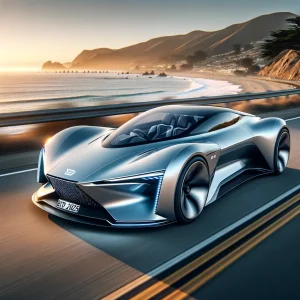Meet the 2026 Hyundai IONIQ 9 Limited: A New Benchmark for 3-Row EVs
The 2026 Hyundai IONIQ 9 Limited is finally on American soil, and it instantly raises the bar for what families should expect from a three-row electric SUV. Built on Hyundai’s E-GMP platform and positioned above the popular IONIQ 5, the new flagship stretches beyond Palisade dimensions while packing a state-of-the-art 110 kWh battery pack. With its 422 hp dual-motor layout, 516 lb-ft of torque and EPA-estimated 311-mile Hyundai IONIQ 9 range, the 2026 Hyundai IONIQ 9 delivers sports-sedan thrust and minivan practicality in one futuristic shell. Early adopters overseas have praised its pixelated lighting signature, and U.S. shoppers can now see why – virtually every passer-by stops to ask what it is. In this in-depth IONIQ 9 Limited review, we spent a full week living with the vehicle, testing charging speeds, towing capacity, interior tech and real-world comfort. Whether you’re cross-shopping a Kia EV9, Tesla Model X or even a gas-powered Palisade, the 2026 Hyundai IONIQ 9 deserves a close look. Over the next sections we’ll detail exterior design, performance, cabin tech, real-world driving impressions and pricing so you can decide if this is the ultimate family EV. For more background on Hyundai electric SUV developments, check out our guide to the E-GMP platform and our comparison of IONIQ 5 vs. IONIQ 9.

Striking Pixel Design & Aerodynamics: Exterior Walk-Around
Hyundai designers managed to make the 2026 Hyundai IONIQ 9 turn more heads than some six-figure exotics. Up front, a full-width pixel LED light bar integrates seamlessly into a gloss-black panel hiding radar and camera hardware. Active grille shutters beneath feed cooling air only when necessary, helping the SUV achieve an impressive 0.269 drag coefficient – slippery for something larger than a Palisade. The side profile combines blocky proportions with rounded surfacing, a look that’s both bold and wind-cheating. Retractable door handles sit flush at speed, while satin-chrome window trim contrasts a dramatic matte-gray body-color option (a $1,000 up-charge worth every penny if you want curb appeal).
Rolling stock is equally functional: 21-inch aero-optimized alloys wear Hankook iON Evo EV-specific tires (285/45R21) that quell road noise and support the SUV’s 5,971-lb curb weight. Out back, vertical LED blades link with the roof-mounted third brake light to create a continuous, inverted U-shaped signature that some compare to a Cadillac Escalade but with unmistakable pixel flair. Practical touches abound too—power-operated charge door, flat silver roof rails, and parking sensors that wrap the corners for low-speed confidence. If you appreciate Hyundai electric SUV design language but need true family space, this is the most expressive statement yet. For a deeper dive into aero wheels, see our piece on why EV wheel design matters for range.

Battery, Charging & Performance: 311-Mile Freedom on Tap
Under the sleek skin sits the heart of the 2026 Hyundai IONIQ 9: a 110 kWh lithium-ion pack paired with dual 157 kW motors delivering 422 hp. Stomp the accelerator and this three-row electric SUV sprints to 60 mph in a verified 4.9 seconds—quicker than many midsize sports sedans. Yet efficiency hasn’t been sacrificed; the EPA rates the IONIQ 9 Limited at 91 MPGe city / 79 MPGe highway / 85 MPGe combined, and during our week-long IONIQ 9 Limited review we averaged 3.0 mi/kWh in mixed driving.
Charging flexibility is another highlight. Using an at-home 240-V Level 2 wallbox, the battery refills from 10-100 % in 9 hours 40 minutes—perfect for overnight top-ups. On the road, the native NACS port taps directly into Tesla’s Supercharger V3 network, replenishing 10-80 % in 40 minutes. Prefer CCS? An included 350 kW adapter slashes that to a blistering 24 minutes, thanks to 800-V architecture and battery pre-conditioning. There’s even a 50 kW fallback option for legacy stations. Hyundai’s Vehicle-to-Load system (V2L) supplies 120 V/1.9 kW to power camping gear, tools or a home fridge during outages.
Add a 5,000-lb tow rating and HTRAC all-wheel drive with multiple regen levels controlled by steering-wheel paddles, and the 2026 Hyundai IONIQ 9 becomes a genuine adventure rig. After this section, we’ll embed our full driving video so you can watch charging demos and acceleration launches in real time.
Luxury Lounge on Wheels: Interior Space, Tech & Family Comfort
Open the power tailgate and you’re met with 21.9 cu-ft of cargo room behind the power-folding third row—expanding to a cavernous 86.9 cu-ft with all seats flat. The cabin design mirrors the pixel theme yet feels airy and premium. Soft-touch dash materials, ambient LED strips, and ribbed door inserts create a minimalist vibe, while the dual 12.3-inch curved displays run Hyundai’s latest infotainment with wireless Apple CarPlay/Android Auto, over-the-air updates and in-dash EV route planning. Although real leather isn’t offered, the ventilated Hexa-pore leatherette seats proved comfy for 300-mile test loops and include power ottomans in both first and second rows—a rarity even among luxury brands.
Rear occupants enjoy independent climate controls, manual sunshades, Bose 14-speaker audio and plenty of charging: three 100-W USB-C ports up front, two more in the seatbacks plus an in-trunk 120-V outlet governed by the adaptive Vehicle-to-Load inverter. The flat floor made possible by the dedicated EV platform provides walk-through access to the third row, where adults up to six feet tall fit for short hops thanks to power-recline backrests. Fingerprint authentication loads personalised settings instantly, and Digital Key 2+ lets you use an iPhone or Galaxy as the primary key fob—ideal for active lifestyles. If you’re researching cabin tech across Hyundai electric SUV models, see our deep dive into Bluelink connected services.

On-Road Impressions, Safety & Driver-Assist Technology
How does the 2026 Hyundai IONIQ 9 drive in the real world? Whisper-quiet. Hankook iON Evo tires, double-pane acoustic glass and meticulous chassis tuning keep wind and road noise to a hush, rivaling premium marques. The low centre of gravity masks the near-6,000-lb curb weight; body roll is well controlled and steering response is linear, though purists might crave more feedback. Four regen levels—including i-Pedal one-pedal mode—enable city driving with minimal brake use and extend the Hyundai IONIQ 9 range beyond its EPA figure in traffic.
Safety is comprehensive: Highway Driving Assist 2 combines adaptive cruise, lane-centering and machine-learning lane changes for semi-hands-free cruising, while blind-spot camera feeds appear in the cluster with each indicator flick. Surround-View Monitor stitches crisp imagery that makes tight parking bays stress-free, and rear cross-traffic avoidance, Safe Exit Assist, plus eight airbags come standard. The Limited trim misses out on Remote Smart Parking Assist, a feature reserved for the Calligraphy grade, but most buyers won’t notice.
During our week-long IONIQ 9 Limited review we road-tripped, grocery-ran and even towed a pair of e-bikes; the SUV never felt strained. Regenerative braking handled steep descents around the Blue Ridge Parkway, and battery temperatures stayed in the sweet spot thanks to automatic pre-conditioning. For driving dynamics comparisons, see our internal article contrasting IONIQ 9 vs. Kia EV9 ride quality.

Pricing, Competition & Final Verdict on the 2026 Hyundai IONIQ 9 Limited
The 2026 Hyundai IONIQ 9 Limited starts at $73,100 before destination, sitting two trims below the Calligraphy Design yet already feeling like a luxury flagship. Factor in the potential $7,500 federal Clean Vehicle credit (check income and assembly qualifications) and the real-world transaction price can undercut a comparably equipped Tesla Model X or Rivian R1S by tens of thousands. Standard equipment lists read like an options sheet on many rivals: panoramic roof, ventilated first- and second-row seats, Bose audio, pixel LED lighting, 5,000-lb tow package and 800-V ultrafast charging hardware are all baked in.
Key competitors include the Kia EV9 GT-Line, Volvo EX90 and upcoming Toyota bZ Large SUV. Against this set, the 2026 Hyundai IONIQ 9 wins on charging speed, interior flexibility and sheer wow factor. Only Volvo challenges its safety tech breadth, while the EV9 matches passenger space but falls short on performance. Hyundai’s 10-year/100,000-mile powertrain warranty and three years of 30-minute Electrify America sessions sweeten the ownership proposition.
In closing, the 2026 Hyundai IONIQ 9 Limited is the most complete three-row electric SUV we’ve tested to date. It blends distinctive styling, sports-car acceleration, family-friendly ergonomics and class-leading fast charging into one futuristic package. If you crave an EV that can replace both your crossover and your minivan, the 2026 Hyundai IONIQ 9 should top your test-drive list. For next steps, explore our guide to Level 2 home charging installation and our Palisade vs. IONIQ 9 cost-of-ownership calculator.







